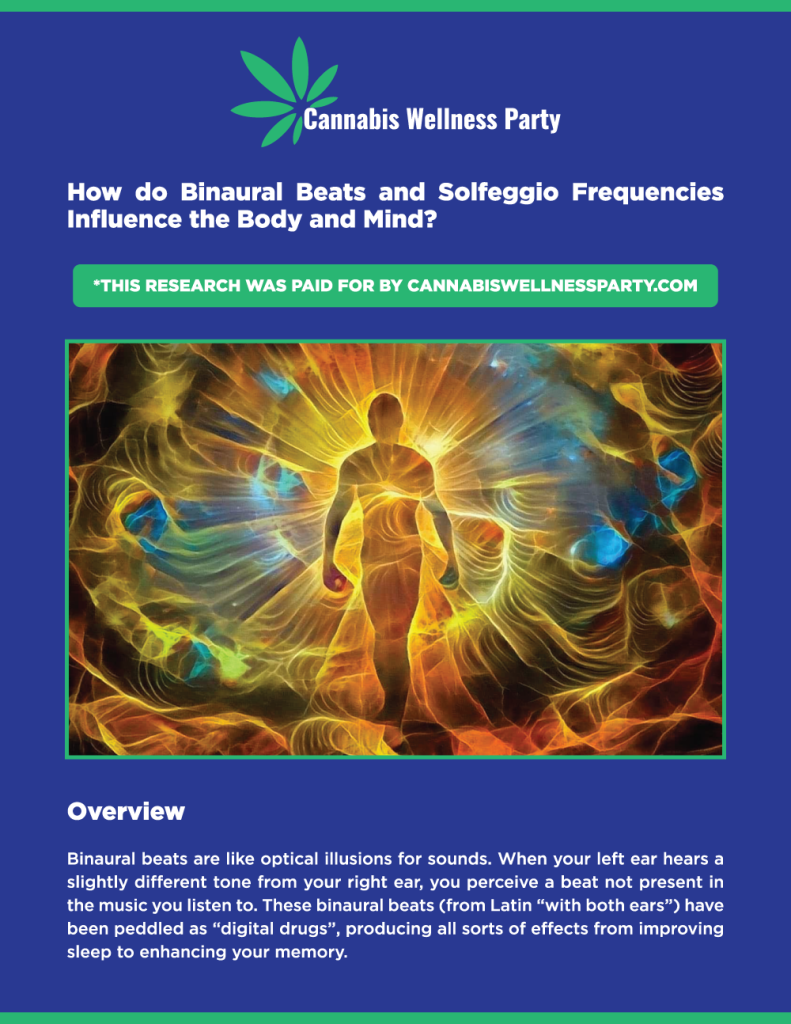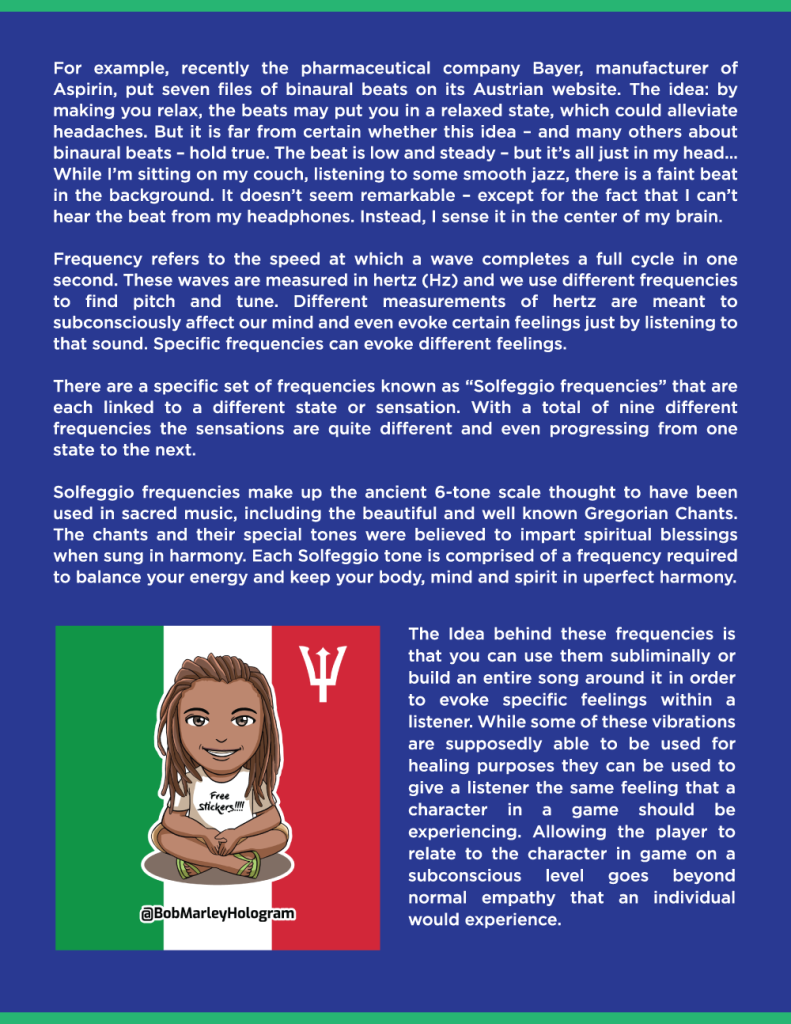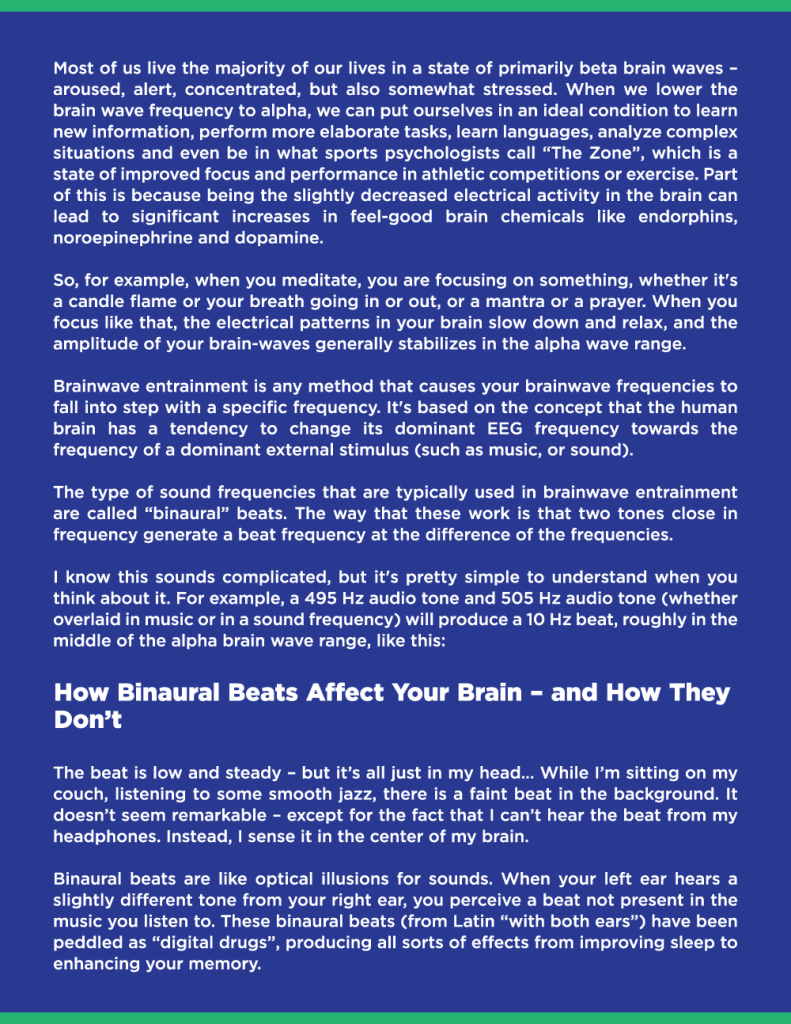October 24, 2021
How do Binaural Beats and Solfeggio Frequencies Influence the Body and Mind?
How do Binaural Beats and Solfeggio Frequencies Influence the Body and Mind?
*This research was paid for by www.CannabisWellnessParty.com and www.BobCapella.com
Overview
Binaural beats are like optical illusions for sounds. When your left ear hears a slightly different tone from your right ear, you perceive a beat not present in the music you listen to. These binaural beats (from Latin “with both ears”) have been peddled as “digital drugs”, producing all sorts of effects from improving sleep to enhancing your memory.








For example, recently the pharmaceutical company Bayer, manufacturer of Aspirin, put seven files of binaural beats on its Austrian website. The idea: by making you relax, the beats may put you in a relaxed state, which could alleviate headaches. But it is far from certain whether this idea – and many others about binaural beats – hold true. The beat is low and steady – but it’s all just in my head… While I’m sitting on my couch, listening to some smooth jazz, there is a faint beat in the background. It doesn’t seem remarkable – except for the fact that I can’t hear the beat from my headphones. Instead, I sense it in the center of my brain.
Frequency refers to the speed at which a wave completes a full cycle in one second. These waves are measured in hertz (Hz) and we use different frequencies to find pitch and tune. Different measurements of hertz are meant to subconsciously affect our mind and even evoke certain feelings just by listening to that sound. Specific frequencies can evoke different feelings.
There are a specific set of frequencies known as “Solfeggio frequencies” that are each linked to a different state or sensation. With a total of nine different frequencies the sensations are quite different and even progressing from one state to the next.
Solfeggio frequencies make up the ancient 6-tone scale thought to have been used in sacred music, including the beautiful and well known Gregorian Chants. The chants and their special tones were believed to impart spiritual blessings when sung in harmony. Each Solfeggio tone is comprised of a frequency required to balance your energy and keep your body, mind and spirit in uperfect harmony.
The Idea behind these frequencies is that you can use them subliminally or build an entire song around it in order to evoke specific feelings within a listener. While some of these vibrations are supposedly able to be used for healing purposes they can be used to give a listener the same feeling that a character in a game should be experiencing. Allowing the player to relate to the character in game on a subconscious level goes beyond normal empathy that an individual would experience.
Most of us live the majority of our lives in a state of primarily beta brain waves – aroused, alert, concentrated, but also somewhat stressed. When we lower the brain wave frequency to alpha, we can put ourselves in an ideal condition to learn new information, perform more elaborate tasks, learn languages, analyze complex situations and even be in what sports psychologists call “The Zone”, which is a state of improved focus and performance in athletic competitions or exercise. Part of this is because being the slightly decreased electrical activity in the brain can lead to significant increases in feel-good brain chemicals like endorphins, norepinephrine and dopamine.
So, for example, when you meditate, you are focusing on something, whether it’s a candle flame or your breath going in or out, or a mantra or a prayer. When you focus like that, the electrical patterns in your brain slow down and relax, and the amplitude of your brain-waves generally stabilizes in the alpha wave range.
Brainwave entrainment is any method that causes your brainwave frequencies to fall into step with a specific frequency. It’s based on the concept that the human brain has a tendency to change its dominant EEG frequency towards the frequency of a dominant external stimulus (such as music, or sound).
The type of sound frequencies that are typically used in brainwave entrainment are called “binaural” beats. The way that these work is that two tones close in frequency generate a beat frequency at the difference of the frequencies.
I know this sounds complicated, but it’s pretty simple to understand when you think about it. For example, a 495 Hz audio tone and 505 Hz audio tone (whether overlaid in music or in a sound frequency) will produce a 10 Hz beat, roughly in the middle of the alpha brain wave range, like this:
How Binaural Beats Affect Your Brain – and How They Don’t
The beat is low and steady – but it’s all just in my head… While I’m sitting on my couch, listening to some smooth jazz, there is a faint beat in the background. It doesn’t seem remarkable – except for the fact that I can’t hear the beat from my headphones. Instead, I sense it in the center of my brain.
Binaural beats are like optical illusions for sounds. When your left ear hears a slightly different tone from your right ear, you perceive a beat not present in the music you listen to. These binaural beats (from Latin “with both ears”) have been peddled as “digital drugs”, producing all sorts of effects from improving sleep to enhancing your memory.
For example, recently the pharmaceutical company Bayer, manufacturer of Aspirin, put seven files of binaural beats on its Austrian website. The idea: by making you relax, the beats may put you in a relaxed state, which could alleviate headaches. But it is far from certain whether this idea – and many others about binaural beats – hold true.
The binaural beat percept
let take a loudspeaker. We’ll play two sine waves, one with a frequency of 440 Hertz (cycles per seconds) and one of 446 Hertz. The sound travels to your ear and the two waves interact with each other, either cancelling each other out or amplifying each other. The sound waxes and wanes periodically: this is called a beat, specifically a monaural beat.
Two waves of different frequencies (red and blue signals) added to create a third signal (bottom panel, pink). This new signal contains a 6 Hz beat (e.g., a 6 cycle per second rhythm). The red and blue signals and also show behind the new signal.
The frequency of the beat is equal to the differences in frequency between the two original sine waves – in this case, 6 Hertz.
Now, let’s take a set of headphones. We’ll split the two waves, and play a sine wave of 440 Hertz in your left ear and a sine wave of 446 Hertz in your right ear. Now, what do you hear?
Again, you’ll hear a beat of 6 Hertz. But now there is no room for the two waves to physically interact – it is all in your head. While monaural beats can be heard when you listen with both ears, one ear is enough to perceive them (hence “monaural” from the Latin phrase “with one ear”). Binaural beats, however, can only be perceived with both ears, hence their name derives from “with both ears”. They also differ in how you perceive them: monaural beats pulse from very loud to silent, while binaural beats only change slightly in volume.
We still do not know for sure which brain regions are involved in generating the binaural beat percept. A part of the brain called the superior olivary nucleus may be one such region, but this is not yet certain.
Heinrich Wilhelm Dove, a German experimenter, first discovered binaural beats in 1839. Much of what we know about binaural beats comes from an article by Gerald Oster, published in Scientific American in 1973. Oster envisioned binaural beats as a tool in research and medicine, allowing researchers to investigate the neuronal basis of hearing.
He might be surprised if he did a quick Google search to see what binaural beats are used for today. A whole industry has been built on the illusion (as we’ll see) that binaural beats improve your wellbeing. These claims range from helping you meditate, increasing your IQ, making you relax and sleep, promoting creativity, reducing anxiety, to activating your self-healing abilities.
In September, the pharmaceutical company Bayer released seven tracks of binaural beats on its Austrian website. Presented under the title “Good Vibes for our brain – powered by Aspirin”, the website proposes that binaural beats are “a pleasant and easy way to e.g. alleviate headaches through relaxation”.
One way in which binaural beats may influence brain waves is through entrainment. Entrainment here means that the activity of your EEG becomes similar to a certain frequency set by an external stimulus.
The researchers found that beats can modulate oscillations and phase synchronization. But for binaural beats, they mostly observed a decrease in EEG power and phase synchronization. This means that there are weaker brain waves at the frequency of the beat, and the EEG phases across the brain fall more out of sync. Only when the patients listened to 10 Hz and 40 Hz binaural beats did EEG power increase, i.e., there were stronger brain waves at these frequencies. This entrainment had previously been described for 40 Hz binaural beats.
But will binaural beats make your headache go away? You can test it on yourself when your head hurts next time – but science says: we just don’t know, yet.
Binaural beats are not digital drugs
Now, could this entrainment really have an effect on your memory, creativity or pain perception? It is probably safest to say that the jury is still out on this question. A 2015 review of the available literature summarized several studies on the effect of binaural beats on memory, creativity, attention, anxiety, mood and vigilance. The authors concluded that for most of these applications, findings are either contradictory or only supported by a single study. The only consistent finding was that several studies reported that binaural beat stimulation reduces anxiety levels. How anxiety is reduced, however, is not yet understood.
One study suggested that binaural beats may increase relaxation after exercise. However, the subjects in this study listened to binaural beats in the theta range, 4-7 Hertz. Another study reported that study participants subjectively rated pain lower after they listened to binaural beats at 8, 10 and 12 Hertz, i.e., in the alpha range. So while there is no definite proof that binaural beats increase relaxation or reduce pain, further research may back this idea up.
And this is the problem with binaural beat research – we still do not know how the illusion of binaural beats is generated in our brains, or which brain networks are affected by them. If we knew, experimental standards could be harmonized and optimized to probe and report the effects of binaural beats more accurately. As it is, protocols vary widely between different studies – from which wave ranges are tested to how long subjects listen to beats and what background frequencies are used. All of these may impact the effect of binaural beats on brain waves, mood or pain – but we don’t know it.
Just a few examples of how funny these beats are: older people can detect beats in the gamma range, but not as accurately as younger people. Men and women may perceive binaural beats differently, and perception may change throughout the menstrual cycle. Given that we can’t explain these observations, we need to properly understand binaural beats before we can probe their effect. And yes, music might help you relax, and this might improve your headache – or mood, anxiety, creativity, or sleep. But will binaural beats make your headache go away? You can test it on yourself when your head hurts next – but science says: we just don’t know, yet.
References
https://studysoundpsychology.wordpress.com/2015/03/07/the-effects-of-frequency-on-the-brain/
http://greenredproductions.com/solfeggio-frequencies/
http://www.attainablemind.com/2010/04/solfeggio-frequencies-binaural-beats.html
https://attunedvibrations.com/solfeggio/

0 Comments
Leave A Comment